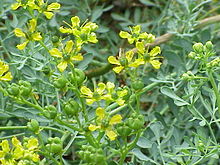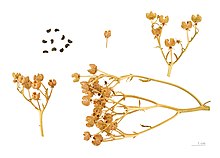Ruta graveolens: Difference between revisions
→Chemistry: {{cite journal | doi = |
→Culinary use: {{cite journal | doi = |
||
| Line 39: | Line 39: | ||
* Seeds can be used for porridge. |
* Seeds can be used for porridge. |
||
* The bitter leaf can be added to eggs, cheese, fish, or mixed with damson plums and wine to produce a meat sauce. |
* The bitter leaf can be added to eggs, cheese, fish, or mixed with damson plums and wine to produce a meat sauce. |
||
* In Italy in [[Friuli Venezia Giulia|Friuli Venezia-Giulia]],the young branches of the plant are dipped in a batter, deep-fried in oil, and consumed with salt or sugar. They are also used on their own to aromatise a specific type of omelette.<ref> |
* In Italy in [[Friuli Venezia Giulia|Friuli Venezia-Giulia]],the young branches of the plant are dipped in a batter, deep-fried in oil, and consumed with salt or sugar. They are also used on their own to aromatise a specific type of omelette.<ref>{{cite journal | doi = 10.1186/1746-4269-3-22}}</ref> |
||
=== Other === |
=== Other === |
||
Revision as of 16:06, 18 March 2013
| Common Rue | |
|---|---|

| |
| Common Rue in flower | |
| Scientific classification | |
| Kingdom: | |
| (unranked): | |
| (unranked): | |
| (unranked): | |
| Order: | |
| Family: | |
| Genus: | |
| Species: | R. graveolens
|
| Binomial name | |
| Ruta graveolens | |
Ruta graveolens, commonly known as rue, common rue or Herb-of-Grace, is a species of Ruta grown as a herb. It is native to the Balkan Peninsula, southeastern Europe. It is now grown throughout the world as an ornamental plant in gardens, especially because of its bluish leaves, and also sometimes for its tolerance of hot and dry soil conditions. It also is cultivated as a medicinal herb, as a condiment, and to a lesser extent as an insect repellent.
The caterpillars of the Papilio machaon butterfly species feed on rue, among other kinds of plants.[citation needed]
Uses
Traditional use
Common Rue is said to promote the onset of menstruation and of uterine contractions;[citation needed] for this reason the refined oil of rue was cited by the Roman historian Pliny the Elder and the gynecologist Soranus as a potent abortifacient (inducing abortion). Rue contains pilocarpine which is used in horses to induce abortion.

It is also used in Brazil as the key ingredient in homemade herbal cough syrup, when mashed with caramelized sugar and honey.[1]
Exposure to Common Rue, or herbal preparations derived from it, can cause severe phytophotodermatitis which results in burn-like blisters on the skin.[2][3][4][5]

Culinary use


Rue does have a culinary use if used sparingly, however it is incredibly bitter and severe gastric discomfort may be experienced by some individuals. Although used more extensively in former times, it is not a herb that typically suits modern tastes, and thus its use declined considerably over the course of the 20th century to the extent that it is today largely unknown to the general public and most chefs, and unavailable in grocery stores.[6]
- It was used extensively in ancient Middle Eastern and Roman cuisine (according to Apicius).
- Rue leaves and berries are an important part of the cuisine of Ethiopia.
- Rue is used as a traditional flavoring in Greece and other Mediterranean countries.
- In Istria (a region in Croatia), and in Northern Italy, it is used to give a special flavour to grappa/raki and most of the times a little branch of the plant can be found in the bottle. This is called grappa alla ruta.
- Seeds can be used for porridge.
- The bitter leaf can be added to eggs, cheese, fish, or mixed with damson plums and wine to produce a meat sauce.
- In Italy in Friuli Venezia-Giulia,the young branches of the plant are dipped in a batter, deep-fried in oil, and consumed with salt or sugar. They are also used on their own to aromatise a specific type of omelette.[7]
Other
Rue is also grown as an ornamental plant, both as a low hedge and so the leaves can be used in nosegays. Most cats dislike the smell of it, and it can therefore be used as a deterrent to them (see also Plectranthus caninus).
Chemistry

A series of furanoacridones and of two acridone alkaloids (arborinine and evoxanthine) can be isolated from Ruta graveolens.[8] It also contains coumarins and limonoids.[9]
Cell cultures produces the coumarins umbelliferone, scopoletin, psoralen, xanthotoxin, isopimpinellin, rutamarin and rutacultin (6,7-dimethoxy- 3-(1,1-dimethylallyl)coumarin), and the alkaloids skimmianine, kokusaginine, 6-methoxydictamnine and edulinine (1-methyl-4-methoxy-3-[2,3-dihydroxy-3-methylbutyl]-2-quinolone).[10]
The ethyl acetate extract of Ruta graveolens leaves yields two furanocoumarins, one quinoline alkaloid and four quinolone alkaloids.[11][12]
The chloroform extracts of the root, stem and leaf shows the isolation of the furanocoumarin chalepensin.[13]
The essential oil of R. graveolens contains two main constituents undecan-2-one (46.8%) and nonan-2-one (18.8%).[14]
Literary references
Rue is mentioned in the Bible, Luke 11.42: "But woe unto you, Pharisees! For ye tithe mint and rue and all manner of herbs".
Rue is well known for its symbolic meaning of regret and it has sometimes been called "herb-of-grace" in literary works. It is one of the flowers distributed by the mad Ophelia in William Shakespeare's Hamlet (IV.5):
- "There's fennel for you, and columbines:
- there's rue for you; and here's some for me:
- we may call it herb-grace o' Sundays:
- O you must wear your rue with a difference..."
It was planted by the gardener in Richard II to mark the spot where the Queen wept upon hearing news of Richard's capture (III.4.104–105):
- "Here did she fall a tear, here in this place
- I'll set a bank of rue, sour herb of grace."
It is also given by the rusticated Perdita to her disguised royal father-in-law on the occasion of a sheep-shearing (Winter's Tale, IV.4):
- "For you there's rosemary and rue; these keep
- Seeming and savour all the winter long."
It is used by Michael in Milton's Paradise Lost to give Adam clear sight (11.414):
- "Then purg'd with euphrasy and rue
- The visual nerve, for he had much to see."

Rue is considered a national herb of Lithuania and it is the most frequently referred herb in Lithuanian folk songs, as an attribute of young girls, associated with virginity and maidenhood. It was common in traditional Lithuanian weddings for only virgins to wear a rue (ruta) at their wedding, a symbol to show their purity. Likewise, rue is prominent in the Ukrainian folklore, songs and culture.
In mythology, the basilisk, whose breath could cause plants to wilt and stones to crack, had no effect on rue. Weasels who were bitten by the basilisk would retreat and eat rue in order to recover and return to fight.
The Tacuinum Sanitatis, a medieval handbook on wellness, lists these properties of rue:
- Nature: Warm and dry in the third degree.
- Optimum: That which is grown near a fig tree.
- Usefulness: It sharpens the eyesight and dissipates flatulence.
- Dangers: It augments the sperm and dampens the desire for coitus.
- Neutralization of the Dangers: With foods that multiply the sperm.
Rue is used by Gulliver in "Gulliver's Travels" (by Jonathan Swift) when he returns to England after living among the "Houyhnhnms". Gulliver can no longer stand the smell of the English Yahoos (people), so he stuffs rue or tobacco in his nose to block out the smell. "I was at last bold enough to walk the street in his (Don Pedro's) company, but kept my nose well with rue, or sometimes with tobacco".
In The Hunger Games, Rue is the name of a 12-year-old girl whom Katniss allies with in the arena.
Songs associated with rue
"Chervona Ruta" (Червона Рута—"Red Rue")—a song, written by Volodymyr Ivasyuk, a popular Ukrainian poet and composer. Pop singer Sofia Rotaru performed the song in 1971. Recently Rotaru performed in a rap arrangement.
The progressive metal band Symphony X named a song "Absinthe and Rue" on their first album, Symphony X, and Kathleen Battle, American soprano, has recorded the song cycle "Honey and Rue" written by composer Andre Previn in collaboration with the Nobel Laureate Toni Morrison.
Many traditional English and Ukrainian folk songs use rue to symbolise regret. Often it is paired with thyme: thyme used to symbolise virginity, and rue the regret supposed to follow its loss. In Ukrainian folk song "Oi poli ruta, ruta" (O, rue, rue in the field), the girl regrets losing her virginity, reproaching the lover for "breaking the green hazel tree" and repeatedly calls for respect.[15]
"Una Matica de Ruda" is a traditional Sephardic wedding song, dating back to the Middle Ages.
See also
- Peganum harmala, an unrelated plant also known as "Syrian rue"
References
- ^ "Rachel's Rantings in Rio".
- ^ Arias-Santiago, SA; Fernández-Pugnaire, MA; Almazán-Fernández, FM; Serrano-Falcón, C; Serrano-Ortega, S (2009). "Phytophotodermatitis due to Ruta graveolens prescribed for fibromyalgia". Rheumatology (Oxford, England). 48 (11): 1401. doi:10.1093/rheumatology/kep234. PMID 19671699.
- ^ Furniss, D; Adams, T (2007). "Herb of grace: An unusual cause of phytophotodermatitis mimicking burn injury". Journal of burn care & research : official publication of the American Burn Association. 28 (5): 767–9. doi:10.1097/BCR.0B013E318148CB82. PMID 17667834.
- ^ Eickhorst, K; Deleo, V; Csaposs, J (2007). "Rue the herb: Ruta graveolens--associated phytophototoxicity". Dermatitis : contact, atopic, occupational, drug : official journal of the American Contact Dermatitis Society, North American Contact Dermatitis Group. 18 (1): 52–5. doi:10.2310/6620.2007.06033. PMID 17303046.
- ^ Wessner, D; Hofmann, H; Ring, J (1999). "Phytophotodermatitis due to Ruta graveolens applied as protection against evil spells". Contact dermatitis. 41 (4): 232. PMID 10515113.
- ^ "Rue (Ruta graveolens L.)".
- ^ . doi:10.1186/1746-4269-3-22.
{{cite journal}}: Cite journal requires|journal=(help); Missing or empty|title=(help)CS1 maint: unflagged free DOI (link) - ^ Investigation of cytotoxic activity on human cancer cell lines of arborinine and furanoacridones isolated from Ruta graveolens. Rethy Borbala, Zupko Istvan, Minorics Renata, Hohmann Judit, Ocsovszki and Falkay George, Planta medica, 2007, vol. 73, no1, pages 41-48, INIST 18469419
- ^ New coumarins and limonoids of Ruta graveolens. Srivastava S. D., Srivastava S. K. and Halwe K., Fitoterapia, 1998, vol. 69, no 1, pages 7-12, INIST 2179664
- ^ . doi:10.1016/S0031-9422(00)90269-3.
{{cite journal}}: Cite journal requires|journal=(help); Missing or empty|title=(help) - ^ . doi:10.1021/jf0259361.
{{cite journal}}: Cite journal requires|journal=(help); Missing or empty|title=(help) - ^ . doi:10.1021/np50059a021.
{{cite journal}}: Cite journal requires|journal=(help); Missing or empty|title=(help) - ^ . doi:10.1055/s-2006-961917.
{{cite journal}}: Cite journal requires|journal=(help); Missing or empty|title=(help) - ^ Potential allelochemicals from the essential oil of Ruta graveolens. De Feo Vincenzo, De Simone Francesco and Senatore Felice, Phytochemistry, 2002, vol. 61, no 5, pages 573-578, INIST 13994117
- ^ Oi u poli ruta, ruta (O, rue, rue in the field).
{{cite book}}:|first=missing|last=(help)CS1 maint: extra punctuation (link) (Ukrainian)
External links
- Rue (Ruta graveolens L.) page from Gernot Katzer's Spice Pages
- [1] from the blog Rachel's Rantings in Rio
